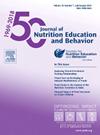好食物袋案例研究与评价:青年领导与校本花园对营养教育与社区健康的价值
IF 2.3
3区 医学
Q2 EDUCATION, SCIENTIFIC DISCIPLINES
引用次数: 0
摘要
本“优质食品袋计划”(GFB)案例研究和评估的主要目的是为一个新兴计划提供证据。研究结果探讨了大学伙伴关系、跨年级合作和学校花园空间的使用如何提高社区营养影响。理论或研究的使用费城十分之一的家庭无法持续获得负担得起的健康食品。多项研究表明,接受“免费食品”的耻辱会给有需要的家庭提供食品援助项目带来负担。目标受众:来自三个学校站点的“好食物袋”的接受者,包括学生、教师和社区成员。教职员和青年领袖从事学校花园和监督GFB分发。该项目是Agatston城市营养倡议(AUNI)的一个食品主权项目。这个为期六周的夏季计划每周为接受者提供CSA分享,来自大学援助社区学校(UACS)花园的农产品,以及食谱/营养信息。跨年级的倡议整合了K-12学生,以促进围绕营养和营养教育的以青年为基础的变革和社区建设。评估方法数据包括1011.11磅农产品的行政数据、从GFB接受者那里收集的59项分发后调查、6个主要工作人员个人访谈以及分发的观察性反思。结果65%的受助人报告说,他们的饮食习惯有了重大改善,营养有所增加。只有4%的人(1或2个人)报告说每天不吃水果或蔬菜。有多名成员接受塑料袋的家庭报告称,在主餐中食用两种或更多蔬菜的比例明显更高(p <;. 05)。虽然只有5%的农产品来自UACS花园,但它在袋子里补充了与文化相关的农产品和相关食谱。定性数据还显示,学生参与度和跨年级互动是项目成功的关键因素。以花园为基础的营养教育将重点转移到健康饮食和食物系统上,绕过了围绕“免费食物”的污名。GFB是解决粮食不安全问题的一个有价值的模式。长期评估将有助于揭示学校花园、青年领导和代际社区参与如何影响全年的健康生活。FundingSNAP-Ed本文章由计算机程序翻译,如有差异,请以英文原文为准。
Good Food Bag Case Study and Evaluation: The Value of Youth Leadership and School-based Gardens on Nutrition Education and Community Health
Objective
The primary objective of this Good Food Bag Program (GFB) case study and evaluation was to generate evidence of an emerging program. Outcomes were examined to explore how a university partnership, cross-grade collaborations, and use of school garden spaces could enhance community nutritional impacts.
Use of Theory or Research
One in ten Philadelphia households lacks consistent access to affordable, healthy food. Multiple studies have shown that stigmas around accepting “free food” burden food assistance programs to reach families in need.
Target Audience
Recipients of Good Food Bags from three school sites, including students, teachers, and community members. Staff and youth leaders engaged in school gardens and overseeing GFB distributions.
Program Description
GFB is a food sovereignty project of the Agatston Urban Nutrition Initiative (AUNI). The summer six-week initiative offers recipients weekly CSA shares, produce from University-Assisted Community School (UACS) gardens, and recipes/nutritional information. Cross-grade initiatives integrate K-12 students to foster youth-based change and community building around nutrition and nutrition education.
Evaluation Methods
Data include administrative data on the 1011.11pounds of produce, 59 post-distribution surveys collected from GFB recipients, six individual key staff interviews, and observational reflections from distributions.
Results
Sixty-five percent of recipients reported major improvements on their eating habits, noting increases in nutrition. Only 4% (1 or 2 individuals) reported consuming no fruit or vegetables each day. Households with multiple members receiving bags reported significantly higher levels of eating two or more vegetables at main meals (p < .05). While only 5% of the produce distributed came from UACS gardens, it supplemented bags with culturally-relevant produce and associated recipes. Qualitative data also revealed student engagement and cross-grade interactions were key components to program success. Garden-based nutrition education shifted focus at distributions to healthy eating and food-systems, bypassing stigmas surrounding “free food”.
Conclusions
The GFB serves as a valuable model for addressing food insecurity. A longer-term evaluation will help reveal how school gardens, youth leadership, and intergenerational community engagement can impact healthy living year-round.
Funding
SNAP-Ed
求助全文
通过发布文献求助,成功后即可免费获取论文全文。
去求助
来源期刊
CiteScore
4.20
自引率
11.50%
发文量
379
审稿时长
44 days
期刊介绍:
The Journal of Nutrition Education and Behavior (JNEB), the official journal of the Society for Nutrition Education and Behavior, is a refereed, scientific periodical that serves as a global resource for all professionals with an interest in nutrition education; nutrition and physical activity behavior theories and intervention outcomes; complementary and alternative medicine related to nutrition behaviors; food environment; food, nutrition, and physical activity communication strategies including technology; nutrition-related economics; food safety education; and scholarship of learning related to these areas.
The purpose of JNEB is to document and disseminate original research and emerging issues and practices relevant to these areas worldwide. The Journal of Nutrition Education and Behavior welcomes evidence-based manuscripts that provide new insights and useful findings related to nutrition education research, practice and policy. The content areas of JNEB reflect the diverse interests in nutrition and physical activity related to public health, nutritional sciences, education, behavioral economics, family and consumer sciences, and eHealth, including the interests of community-based nutrition-practitioners. As the Society''s official journal, JNEB also includes policy statements, issue perspectives, position papers, and member communications.

 求助内容:
求助内容: 应助结果提醒方式:
应助结果提醒方式:


